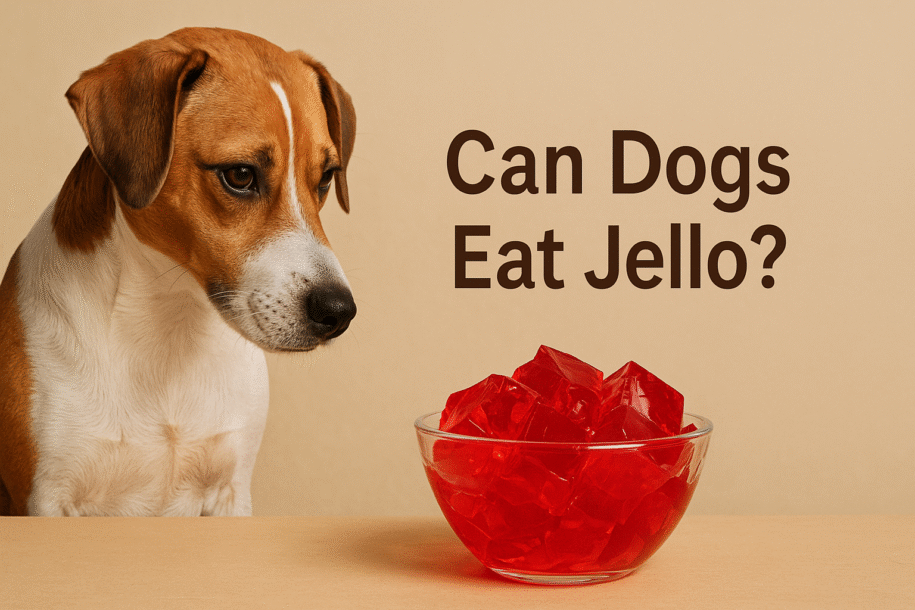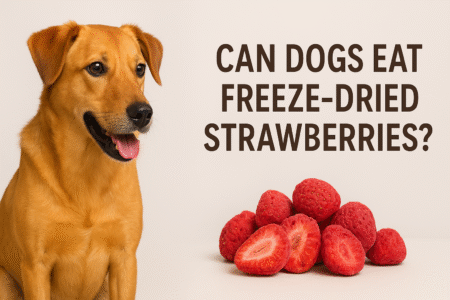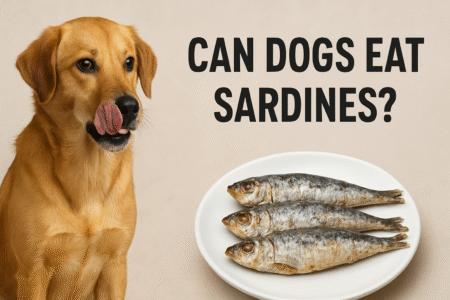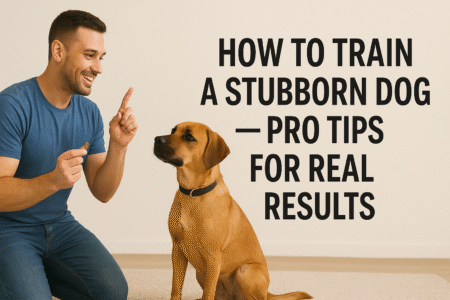Your dog spots that bright, wiggly Jello cup and locks eyes with you. It looks harmless, even fun. But can dogs eat Jello safely? Here’s the quick answer: store-bought Jello is not a safe treat for dogs. It often contains sugar, dyes, artificial flavors, and sometimes xylitol, an artificial sweetener that is dangerous for dogs. Plain, unflavored gelatin is not the same thing, and it can be used in dog-safe treats, but it is optional and not essential for your dog’s diet.
This guide breaks down the risks, explains what dogs can have instead, shares a simple gelatin treat recipe, and outlines what to do if your dog eats Jello, especially if it might be sugar-free.
🦴Key Takeaways:
Store-bought Jello is not safe for dogs — it often contains sugar, dyes, artificial flavors, and preservatives that can upset a dog’s stomach and offer no nutritional value.
Sugar-free Jello is especially dangerous because it may contain xylitol (birch sugar), a sweetener that is toxic and potentially fatal to dogs.
Jello and gelatin are not the same — Jello is a sugary dessert mix, while plain gelatin is just protein and can be used safely in moderation.
Xylitol poisoning can happen fast, causing low blood sugar, seizures, or liver failure. Immediate vet care is crucial if your dog ingests it.
Regular Jello can still cause harm, such as vomiting, diarrhea, hyperactivity, or long-term issues like obesity and dental problems.
Plain, unflavored gelatin (without colors or sweeteners) can be used to make safe, homemade dog treats in small portions.
Gelatin may support joint and skin health, but it’s not a miracle supplement and shouldn’t replace a balanced diet.
Healthy treat alternatives include apple slices, carrots, plain pumpkin, cucumber, or unsweetened yogurt — not sugary desserts.
If your dog eats Jello, check the label for xylitol, stay calm, and contact your vet immediately — don’t wait for symptoms.
Prevention is key: keep desserts out of reach, teach “leave it,” and always check labels for xylitol or sugar alcohols before sharing food.
Is Jello Safe for Dogs? The Real Answer and Why It Matters
Jello and gelatin are not the same. Jello is a dessert mix that includes sugar or artificial sweeteners, flavors, colors, and preservatives, plus gelatin to make it set. Plain gelatin, on the other hand, is just collagen protein with no sugar or additives.
Store-bought Jello is not safe for dogs. Even a spoonful is not worth the risk. Here’s why:
- Sugar can upset a dog’s stomach and contribute to weight gain, dental issues, and inflammation.
- Artificial flavors and colors can trigger sensitivities or mild allergic reactions, such as itching or digestive upset.
- Preservatives may irritate the gut and add no nutritional value for dogs.
- Some sugar-free mixes use xylitol, which is toxic to dogs and can be life-threatening, even in small amounts.
Plain, unflavored gelatin is different. It does not contain sugar or colors, and you can use it to make simple, dog-safe treats if you want. It may offer modest joint and skin support thanks to collagen. But it is not a miracle food, and it should not replace a balanced diet.
Curious about what vets say about flavored mixes? This overview on whether dogs can eat Jell-O explains why added sugars and sugar-free sweeteners raise the risk for dogs. The short version: keep Jello out of the bowl.
What Is in Jello and Why It Can Harm Dogs
Typical Jello ingredients include:
- Sugar or artificial sweeteners
- Artificial flavors
- Artificial colors
- Preservatives
- Gelatin
Why this matters:
- Sugar: Can lead to weight gain, dental issues, and tummy trouble like vomiting or diarrhea.
- Dyes and flavors: May trigger itchy skin or GI sensitivities in some dogs.
- Preservatives: Can irritate the gut and add no nutrition.
- Texture: Large, slippery chunks may pose a minor choking risk for small dogs.
None of this benefits your dog. The risks add up quickly, especially if dessert sharing becomes a habit.
Why Sugar-Free Jello Is Extra Dangerous
Sugar-free Jello often contains xylitol, a sweetener that is highly toxic to dogs. Xylitol can cause a sudden drop in blood sugar, seizures, liver failure, and can be fatal. It sometimes appears on labels as birch sugar. Even small amounts are an emergency.
Quick label red flags to scan for:
- “Sugar-free”
- “No sugar added”
- “Low calorie”
- “Keto dessert”
If your dog ate any sugar-free Jello or a product that lists xylitol or birch sugar, call your vet or an emergency clinic right away. This article from a veterinary practice on xylitol dangers in sweetened products explains how quickly it can cause hypoglycemia and why immediate help matters.
Health Risks From Regular Jello
Regular Jello does not contain xylitol, but it is still not safe or healthy for dogs.
- Likely short-term effects: vomiting, diarrhoea, gas, or hyperactivity from the sugar.
- Long-term risks: obesity, dental disease, and a higher risk of diabetes if sugary treats become a pattern.
- Additive reactions: some dogs are sensitive to dyes and flavors, leading to itching, gassiness, or general tummy upset.
Bottom line: there is no health reason to give Jello to dogs. The risks outweigh any fun factor.
Plain Gelatin vs. Jello: What Dogs Can Have Safely
Plain, unflavored gelatin is a single-ingredient product made from collagen. It is not sweet and has no colors or artificial flavors. Used correctly, it can be part of a simple homemade treat. It is not a required supplement, but it can be a nice occasional extra.
Potential benefits are modest. Gelatin may support skin and joint health in some dogs, but it is not a cure for arthritis or skin problems. Think of it as a small boost, not a treatment.
Safety tips:
- Choose plain, unflavored gelatin only.
- Avoid anything with sweeteners, flavors, or colors.
- Keep servings small to prevent stomach upset.
- Treats, even homemade ones, should make up no more than 10 percent of daily calories.
If you want a deeper explainer on Jello versus gelatin and why added sugars or sweeteners are a problem, see this guide on whether dogs should eat Jello. It reinforces the same guidance: plain gelatin can be used carefully, but flavored mixes are a no.
Plain Unflavored Gelatin Basics
- What it is: Collagen protein, without sugar, dyes, or flavors.
- Possible benefits: May help support joint and skin health, but it is not a complete supplement.
- What to buy: Plain, unflavored gelatin only. Skip mixes with sweeteners or colors.
Easy Dog-Safe Gelatin Treat Recipe
- Ingredients: 1 cup dog-safe, low-sodium broth (no onion or garlic), 1 tablespoon unflavored gelatin. Optional add-ins: a few blueberries or tiny bits of plain cooked chicken.
- Steps:
- Warm the broth until hot but not boiling.
- Whisk in gelatin until fully dissolved.
- Pour into a shallow dish or silicone mold.
- Chill 2 to 4 hours until set, then cut into small cubes.
- Serving: About a 1-inch cube per 20 pounds of body weight. Offer up to a few cubes, a few times per week as a treat. Monitor for tummy upset.
- Safety: Avoid grapes or raisins, avoid sweeteners, keep sodium low, and store in the fridge for 3 to 4 days.
Better Snack Alternatives to Jello
Simple, whole-food options your dog can enjoy:
- Apple slices without seeds, carrots, green beans, cucumber
- Plain canned pumpkin
- Frozen low-sodium broth cubes
- Plain, unsweetened yogurt in small amounts if dairy is tolerated
- Vet-approved dental or chew treats
Keep treats to 10 percent or less of daily calories.
What To Do If Your Dog Ate Jello
Stay calm and check the label right away. Your action plan depends on whether the product might contain xylitol.
If It Might Contain Xylitol, Act Fast
- Check the ingredients for xylitol, sometimes listed as birch sugar. If you are unsure, assume risk.
- Call your vet, an emergency clinic, or a pet poison helpline immediately. Time matters with xylitol.
- Watch for vomiting, weakness, staggering, tremors, or seizures. Do not wait for symptoms to appear before calling.
For a refresher on why xylitol is so dangerous, review this veterinary note on xylitol and sweetened jelly products.
If It Was Regular Jello, What To Watch For
- Expect mild vomiting, diarrhea, or gas in some dogs. Offer water. A bland diet may help if your vet agrees.
- Call your vet if your dog is very young, very small, senior, diabetic, or has symptoms that last longer than 24 hours.
- Do not induce vomiting unless your vet tells you to.
This quick Q&A thread on sugar-free Jello risks highlights why “sugar-free” is a red flag, and why checking labels immediately is so important.
Prevent Future Jello Mishaps
- Storage: Keep desserts and mixes in closed cabinets or the fridge. Use lidded trash cans.
- Training: Teach a strong leave it and drop it. Manage guests during parties.
- Shopping habit: Read labels for xylitol and other sugar alcohols. Avoid sharing human desserts with dogs.
Conclusion
Store-bought Jello is not safe for dogs, and sugar-free Jello can be an emergency because of xylitol. Plain, unflavored gelatin is different and can be used to make simple, dog-safe treats, but it is optional and should be given in small amounts. Choose healthier snacks like veggies, plain pumpkin, or yogurt if tolerated. If your dog ate any sugar-free dessert or shows worrying symptoms, call your vet right away. Keep desserts out of reach, read labels, and stick to treats that truly support your dog’s health.
FAQs:
Can dogs have Jello pudding cups?
No. These often contain sugar, dairy, and additives, and some sugar-free versions may include xylitol.
Is homemade fruit Jello safe?
Not if it includes sugar, sweeteners, or fruit that is unsafe for dogs. Grapes and raisins are toxic.
Can I give gelatin every day?
Small amounts a few times per week are enough. Too much can upset the stomach.
What about bone broth gummies?
If the broth is low-sodium and free of onion or garlic, plain gelatin gummies are a fine treat in small amounts.
Are all sugar alcohols dangerous?
Xylitol is the biggest risk for dogs. When in doubt, skip it and call your vet for guidance.





















Leave a Reply